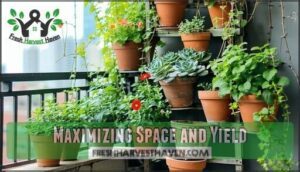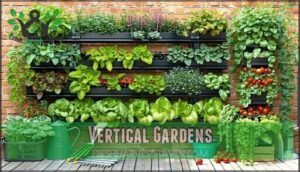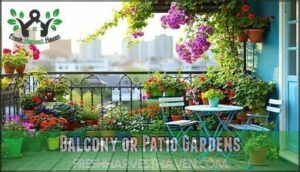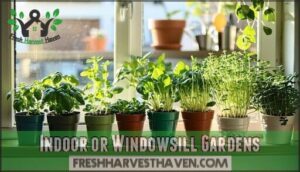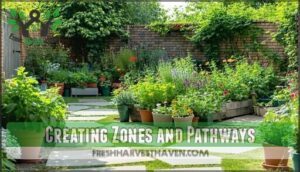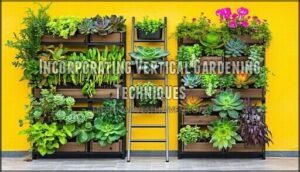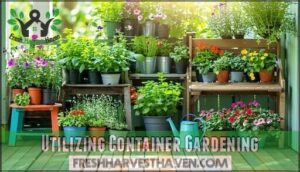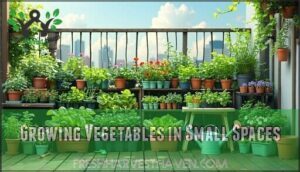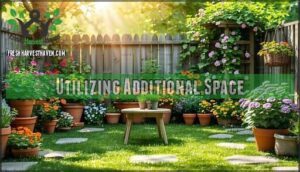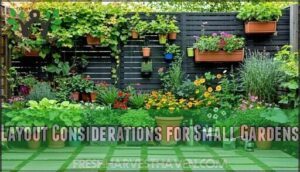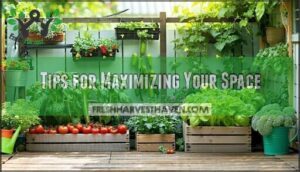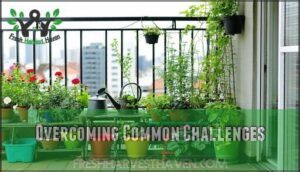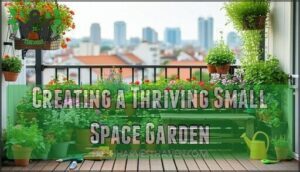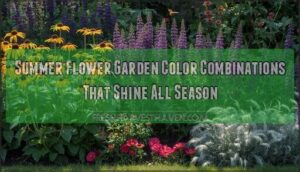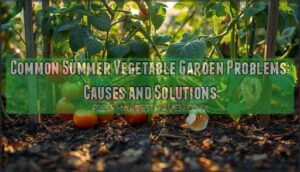This site is supported by our readers. We may earn a commission, at no cost to you, if you purchase through links.
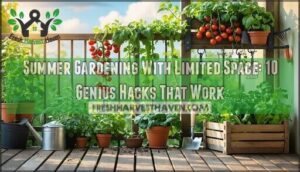
Start by maximizing vertical space with trellises for beans and tomatoes. Choose compact varieties like cherry tomatoes and dwarf peppers that pack flavor into small packages.
Employ square-foot gardening methods to organize your plantings systematically. Container gardening works brilliantly on patios, balconies, or windowsills.
Focus on fast-growing crops like lettuce and radishes for quick wins. Companion planting boosts yields while saving precious real estate.
Even a 4×4 raised bed can feed a family when planned strategically. The secret lies in smart plant selection and creative space utilization techniques.
Table Of Contents
- Key Takeaways
- Choosing The Right Location
- Maximizing Space and Yield
- Types of Small Space Gardens
- Planning a Space-Saving Garden Layout
- Growing Vegetables in Small Spaces
- Utilizing Additional Space
- Layout Considerations for Small Gardens
- Tips for Maximizing Your Space
- Overcoming Common Challenges
- Creating a Thriving Small Space Garden
- Frequently Asked Questions (FAQs)
- How to grow a garden with limited space?
- What vegetables take the least amount of space to grow?
- What is the most common mistake of first time gardeners?
- What makes a good small space garden?
- What is small space gardening?
- How to grow a vegetable garden in limited space?
- Can you grow a garden in a small space?
- What are the different types of small space gardens?
- Does limited space limit your gardening dreams?
- What is the rule of 3 in gardening?
- Conclusion
Key Takeaways
- Maximize vertical space – You’ll triple your growing area by using trellises for climbing plants like beans and tomatoes, installing wall-mounted planters for herbs, and creating tiered displays with repurposed ladders or pallets.
- Choose compact, fast-growing varieties – You can harvest radishes in 21 days, microgreens in 7-14 days, and bush-type tomatoes that deliver full-sized flavor without sprawling, perfect for containers and small plots.
- Practice succession planting – You’ll ensure continuous harvests by planting the same crop every 2-3 weeks, replacing cool-season crops with heat-tolerant varieties, and staggering plantings to avoid feast-or-famine scenarios.
- Optimize your space with strategic planning – You can increase yields by 300% through companion planting, proper container placement in sunny spots, and creating functional zones that group plants by watering needs and growth patterns.
Choosing The Right Location
Your garden’s success depends on finding the ideal microclimate that provides adequate sunlight, proper airflow, and protection from environmental stressors.
Transform any neglected corner into your own thriving food paradise with just sunlight, airflow, and determination.
You’ll need to assess each potential location for at least six to eight hours of direct sunlight daily while ensuring good air circulation to prevent fungal diseases and pest infestations.
Assessing Sunlight and Shade
Every successful summer garden starts with understanding your sunlight hours—the golden key to maximizing your harvest in tight quarters. You’ll need to become a light detective, tracking how sunshine moves across your space throughout the day.
Most vegetables demand 6-8 hours of direct sun, but don’t panic if your area falls short. Shade tolerance varies dramatically between crops, creating opportunities where you might see limitations.
Microclimates within your small space can create perfect growing conditions for different plants. Seasonal shifts change everything, so reassess your sunlight requirements monthly.
- Use reflective surfaces or mirrors to bounce light reflection into darker corners
- Plant shade-tolerant greens like lettuce in spots receiving 3-4 hours of sun
- Vertical gardening structures can create new sunny zones above existing plants
- Track daily sun patterns using your phone’s compass for precise small garden ideas
Selecting a Spot With Good Airflow
After mapping your sun patterns, prioritize air circulation—it’s your plants’ secret weapon against disease.
Position taller specimens where they won’t block natural ventilation systems from reaching shorter neighbors.
In balcony garden setups, create breathable barriers using lattice or mesh for wind protection without stagnation.
Strategic airflow placement strengthens stems, prevents mildew, and encourages pollination in container gardening and vertical gardening systems, maximizing your limited space gardening success.
Protecting From Animals and Pests
Once you’ve secured proper airflow, safeguarding your plants from unwanted visitors becomes paramount.
Installing 2-foot mesh fencing creates effective pest barriers around vulnerable crops. Strategic placement of repellent plants like marigolds and mint provides natural animal deterrents through their pest-repellent properties.
Deer-resistant plants such as lavender discourage larger mammals, while rabbit-repellent plants protect ground-level vegetables. Simple trap systems can manage smaller pests without chemicals.
Companion planting combines pest control with productivity—mixing aromatic herbs with target vegetables confuses insects and creates a living defense system that works around the clock.
Maximizing Space and Yield
You’ll achieve remarkable harvests in compact areas by implementing strategic planting techniques that optimize every square inch of growing space.
These proven methods increase vegetable production by up to 300% through systematic space management and efficient plant selection.
Minimalist Gardening for Small Spaces
Once you’ve secured your ideal location, minimalist gardening becomes your secret weapon for small space gardening success.
Focus on compact vegetables you’ll actually eat—skip space-hogging crops like pumpkins.
Vertical gardening systems and container gardening maximize your small plot potential.
Urban farming thrives with space saving techniques like stackable planters and wall-mounted systems.
Smart garden design turns windowsills into productive micro gardening zones without overwhelming your limited area.
By incorporating elements of small space garden designs, you can create a thriving and efficient garden in even the most limited of spaces.
Growing Fast-Maturing Crops
When space is tight, fast-growing crops become your secret weapon for maximizing summer harvests.
Strategic seed selection focuses on varieties that mature quickly, letting you squeeze multiple growing cycles into your season.
Fast growers like radishes (21 days) and microgreens (7-14 days) deliver instant gratification while compact varieties of spinach and lettuce maximize yields.
Perfect harvest timing and proper soil preparation guarantee continuous production in your small space gardening setup.
Using fast growing seeds is vital for exceptional results.
- Radishes: Ready in 21 days, perfect for succession planting
- Microgreens: Nutritional powerhouses in just 7-14 days
- Leaf lettuce: Harvest in 30 days, regrows after cutting
- Bush beans: Mature in 50 days, ideal for container growing
Companion Planting for Better Growth
Why settle for single-crop containers when you can create plant partners that work together like a dream team? Companion planting transforms your limited space into a thriving ecosystem where growth boosters maximize every square inch.
Pair tomatoes with basil – this classic duo improves flavor while repelling pests naturally. Marigolds act as soil enhancers and pest deterrents throughout your garden.
Try intercropping lettuce between slower-growing vegetables to maximize crop diversity.
For container gardening, combine herbs with flowers to attract beneficial insects. This garden harmony approach creates natural pest control while boosting nutrient uptake, proving that strategic plant partnerships deliver better results than solo growing.
Using Trellises for Vining Crops
Beyond companion planting, trellises transform your vining crops into vertical powerhouses.
These garden structures maximize space optimization by training cucumbers, beans, and peas upward instead of outward. Smart crop support systems can triple your growing area while improving airflow and reducing disease.
Trellis Designs for small space gardening:
- Wire cattle panels bent into arches
- Bamboo teepees for pole beans
- String nets stretched between posts
- Repurposed wooden ladders as vertical gardening supports
Types of Small Space Gardens
You’ll find four primary garden types that maximize productivity in constrained spaces: raised beds, vertical systems, container gardens, and indoor setups.
Each configuration offers specific advantages for different growing conditions, from soil drainage control in raised beds to space multiplication through vertical structures.
They provide unique solutions for various needs, making them suitable for a wide range of gardening scenarios.
Raised Bed Gardens
Raised bed gardening transforms your small space into a productive paradise. These elevated garden boxes give you complete control over soil composition, drainage, and plant health. Your back stays happy during maintenance, while roots thrive in perfectly balanced growing conditions.
Wood selection matters for longevity. Cedar and composite lumber resist rot naturally, while pressure-treated options offer budget-friendly durability. Bed frame construction requires minimal carpentry skills—just four boards and corner brackets.
Consider these essential factors for success:
- Soil depth of 8-12 inches supports most compact plants and vegetables
- Proper drainage prevents waterlogged conditions that kill root growth
- Quality potting mix blended with compost maximizes nutrient availability
- Strategic placement guarantees adequate sunlight for photosynthesis and plant development
Your small space gardening efforts will reward you with higher yields than traditional ground-level plots.
Vertical Gardens
Think of vertical gardening as your secret weapon for turning any wall into a productive growing space.
You’ll transform blank surfaces into thriving garden walls using trellis systems and wall planters that maximize every square inch.
By utilizing effective vertical gardening techniques, you can create a stunning and productive garden in even the smallest of spaces.
| Structure Type | Best Plants | Space Efficiency |
|---|---|---|
| Trellis Systems | Cucumbers, beans, peas | 300% more yield |
| Wall Planters | Herbs, lettuce, spinach | Compact design |
| Hanging Baskets | Cherry tomatoes, strawberries | Vertical greens |
| Modular Towers | Mixed vegetables | Ultimate space savers |
Your vertical greens will enjoy better airflow and drainage while you harvest more from less ground space.
These space savers work perfectly for small space gardening enthusiasts.
Balcony or Patio Gardens
Anyone can turn their outdoor space into a productive garden with strategic patio design and container care.
Your balcony garden thrives when you choose lightweight containers that won’t stress railings or floors.
Patio gardening succeeds with proper drainage holes and quality potting mix—never garden soil, which compacts in containers.
Transform any balcony into your own pocket-sized garden paradise with the right containers and a splash of creativity.
Turn that forgotten corner into a thriving food forest with just a few clever tricks.
Urban gardening requires daily watering since containers dry faster than ground plots.
Smart balcony layout maximizes sunlight exposure while vertical gardening techniques add growing space.
Small space gardening delivers impressive harvests when you select compact varieties and arrange containers efficiently.
Your outdoor oasis awaits, just steps from your door.
Indoor or Windowsill Gardens
While patios offer outdoor growing opportunities, your home’s interior presents untapped potential for year-round harvests. Indoor gardening transforms any sunny window into a productive growing space, regardless of weather conditions outside.
Windowsill Planters filled with Compact Herbs like basil, oregano, and thyme deliver fresh flavors just steps from your kitchen. These smallspace gardening solutions require minimal investment but yield maximum satisfaction.
Micro Greens sprout within days and pack incredible nutritional punch in tiny containers. You’ll harvest baby spinach, arugula, and radish greens in just 7-14 days.
Here’s how to maximize your windowsill gardening success:
- Install Indoor Lighting systems 6-8 inches above plants to supplement natural sunlight during winter months
- Choose well-draining potting mix for proper Soil Selection that prevents root rot in confined spaces
- Position containers on south-facing windows for ideal light exposure throughout the day
Effective winter gardening tips can also enhance your indoor gardening experience by providing valuable insights on plant selection and maintenance.
Your container gardening adventure starts with one small pot and grows from there.
Planning a Space-Saving Garden Layout
You’ll maximize your growing potential when you strategically organize your limited space into functional zones that accommodate different plant types and growth patterns.
Effective layout planning combines vertical structures, designated pathways, and container placement to create a systematic approach that can increase your yield by up to 300% compared to traditional ground-level gardening.
Creating Zones and Pathways
Once you’ve selected your garden type, zone planning transforms chaos into order.
Design your small space like a well-organized kitchen—everything has its place and purpose.
Garden mapping starts with sketching three distinct areas: herbs near your kitchen door, vegetables in the sunniest spot, and containers along edges.
Create pathway design using 18-inch wide corridors between zones—narrow enough to maximize growing space, wide enough for comfortable access.
Group plants by watering needs for efficient maintenance.
Place heavy containers permanently, lighter ones where you can move them seasonally.
Space optimization means every square foot works double duty.
Layout strategies should prioritize function over form—beauty follows when plants thrive in well-planned zones.
Incorporating Vertical Gardening Techniques
When space runs short, growing upward becomes your secret weapon for maximizing every square inch. Vertical gardening transforms ordinary walls and fences into productive powerhouses that’ll make your neighbors wonder how you fit so much green into such a small space.
Vertical Planters and Trellis Systems create impressive yields while maintaining Space Efficiency. You’ll discover that Urban Gardening becomes surprisingly manageable when you use these three strategic approaches:
- Install wall-mounted pocket planters for herbs and leafy greens that cascade beautifully
- Build sturdy trellises for climbing vegetables like beans, peas, and cucumbers
- Repurpose old ladders or pallets as tiered displays for Compact Plants
Garden Walls equipped with proper support systems improve airflow around plants, reducing disease pressure substantially. Your harvesting becomes effortless—no more backbreaking bends to reach ground-level crops. The bonus? Fruits stay cleaner and develop better color when grown vertically. This Small Space solution maximizes production while creating an eye-catching garden display that’s both functional and beautiful.
Utilizing Container Gardening
Container gardening transforms any small space into a productive growing area. You’ll master space optimization through strategic container selection and proper soil mix choices.
- Choose containers with drainage holes and lightweight potting soil
- Group compact plants by similar water management needs
- Position containers to maximize sunlight exposure throughout the day
- Select plant choices suited for your patio garden conditions
Growing Vegetables in Small Spaces
You can transform even the tiniest outdoor space into a productive vegetable garden by selecting compact varieties and using efficient growing techniques.
Smart container placement and proper spacing will maximize your harvest while keeping maintenance simple and manageable.
Choosing Compact and Dwarf Varieties
Once you’ve mapped your garden layout, selecting the right plant varieties becomes your secret weapon.
Dwarf vegetables like ‘BushSteak’ tomatoes and ‘Sweet Golden Baby Belle’ peppers pack full-sized flavor into compact frames. Look for ‘Spacemaster’ cucumbers and ‘Tom Thumb’ peas that thrive in small space gardens.
Mini herbs and compact fruits maximize your harvest without sprawling everywhere. These space savers excel in container gardening and vertical gardening setups.
Choose dwarf varieties with labels like ‘patio,’ ‘bush,’ or ‘miniature’ for guaranteed small flowers and productive yields.
Selecting Easy-to-Grow Vegetables
When you’re just starting your summer gardening journey, choosing the right vegetables makes all the difference between frustration and success.
These beginner-friendly options deliver impressive yields without demanding expert-level care.
Vegetable Choices for Small-Space Success:
- Quick-harvest greens – Lettuce and spinach provide multiple cuttings within 30 days, perfect for succession planting
- Essential herbs – Basil, mint, and chives thrive in containers on sunny windowsills
- Compact fruit producers – Cherry tomatoes and mini peppers yield abundantly on small plants
- Fast root crops – Radishes mature from seed to harvest in just 3-4 weeks
Bush beans practically grow themselves with minimal intervention.
Microgreens transform kitchen counters into nutritional powerhouses.
Summer herbs like thyme and oregano need minimal attention yet provide fresh flavors all season.
These plant varieties guarantee gardening success!
Growing Vegetables in Containers
Smart Container Selection transforms any balcony into your personal harvest hub.
Choose self-watering systems for consistent Water Management during scorching summer days.
Your Soil Mix needs lightweight potting blend, never garden dirt.
Consider Root Depth requirements – tomatoes need 18-inch containers while lettuce thrives in 6-inch pots.
Compact Vegetables excel in container gardening setups.
Practice Crop Rotation between seasons.
Vertical Gardening maximizes yields in small space gardens using spacesaving techniques.
Utilizing Additional Space
You can transform overlooked areas into productive growing zones by strategically placing containers, hanging baskets, and edible plants throughout your property.
These additional spaces often provide the extra square footage needed to expand your harvest without requiring a traditional garden bed, and can help create productive growing zones, making your space more edible.
Strategically Using Containers
Beyond choosing the right vegetables, container selection becomes your secret weapon for small space gardening success. Think of containers as mobile garden plots that adapt to your space’s unique conditions.
Container size directly impacts plant health – deep-rooted vegetables like carrots need 12-inch depth, while shallow-rooted herbs thrive in 6-inch containers. Food-grade buckets with added drainage holes create budget-friendly solutions for container gardening enthusiasts.
Your soil mix foundation determines everything. Skip garden soil and invest in quality potting mix designed for containers – it provides proper aeration and water conservation your plants crave.
Drainage systems prevent root rot disasters. Drill quarter-inch holes every few inches across container bottoms.
Space optimization happens when you group containers by watering schedules and light requirements:
- Stack smaller pots on plant stands for vertical gardens
- Use wheeled plant caddies for sun-chasing mobility
- Place saucers under containers to protect surfaces
Effective fruit gardening tips can also enhance your small space gardening experience.
Adding Hanging Baskets
While containers ground your garden, hanging baskets lift your growing game to new heights.
These hanging planters turn unused overhead areas into productive space-efficient gardens through smart vertical expansion.
Select baskets with drainage holes and sturdy construction—weight limits matter when soil gets waterlogged.
Mount with heavy-duty hooks rated for twice your basket’s filled weight.
Basket materials like coconut coir retain moisture better than plastic during summer heat.
Fill with lightweight potting mix and choose compact varieties: cherry tomatoes, strawberries, and trailing herbs thrive overhead.
This space optimization strategy maximizes your garden footprint without claiming floor space.
Water daily since elevated containers dry faster.
Position baskets where you can easily reach them—your back will thank you during harvest season.
These vertical gardening techniques transform any ceiling into growing real estate.
Using Front Yard Space for Edibles
Your front yard holds untapped potential for edible landscaping that combines beauty with productivity.
Replace traditional grass with colorful Swiss chard, compact vegetables, and dwarf fruit trees to create stunning urban farming displays.
Consider these front yard garden benefits:
- Increased property value through unique small space design
- Year-round harvests of fresh edible flowers and vegetables
- Community inspiration showcasing sustainable vertical garden concepts.
Check HOA rules, then transform your landscape into a food-producing masterpiece.
Utilizing Garden Borders
Along the edges of your outdoor space, garden borders create untapped potential for maximizing yields.
These boundary zones between pathways and planting areas offer perfect opportunities for border planting and edge gardening techniques.
Transform neglected margins into productive growing zones with strategic space optimization:
- Herb borders – Plant aromatic herbs like rosemary and lavender along walkways for natural pest control
- Compact vegetables – Utilize border designs with lettuce, radishes, and dwarf varieties for continuous harvests
- Vertical elements – Install garden fencing or trellises against existing structures for climbing crops
Your small garden’s borders become hardworking real estate.
Layout Considerations for Small Gardens
You’ll need to carefully plan your garden’s layout to guarantee each plant receives adequate sunlight, water access, and proper spacing for ideal growth.
Strategic positioning of containers, pathways, and vertical structures maximizes your limited space while maintaining the essential growing conditions your vegetables require to thrive.
Providing Adequate Sunlight
Understanding sunlight patterns transforms your small garden into a productive powerhouse.
Most vegetables demand 6-8 sunlight hours daily, but you can work with what you’ve got.
Map your space throughout the day to identify sunny spots and areas with afternoon shade.
Create microclimates by positioning heat-loving tomatoes near south-facing walls while placing shade tolerance crops like lettuce in partial shade.
Reflective surfaces like mirrors or aluminum foil amplify available light, while grow lights extend your growing season indoors.
Smart sunlight management maximizes every ray.
Efficient Watering Systems
Smart watering transforms your compact garden into a thriving oasis.
Drip irrigation systems deliver precise moisture directly to root zones, cutting water waste by 50% while maintaining ideal soil moisture levels. Rain barrels capture free water for sustainable irrigation, and soaker hoses provide gentle, consistent watering.
- Timer-controlled drip systems automatically water plants at dawn
- Self-watering containers with built-in reservoirs eliminate daily watering
- Moisture sensors monitor soil conditions and trigger irrigation when needed
- Modular sprinkler systems cover multiple garden zones efficiently
Soil Quality and Fertility
Quality soil forms the foundation of every thriving small-space garden, regardless of your container dimensions. You’ll need well-drained soil that maintains proper pH levels between 6.0-7.0 for ideal nutrient cycling.
Start with soil testing to understand your baseline conditions before adding amendments. This scientific approach prevents guesswork and costly mistakes.
- Compost usage: Mix organic matter weekly to boost microbial activity and soil structure
- Fertilizer types: Choose slow-release options that won’t overwhelm confined root systems
- Nutrient-rich soil: Layer worm castings for sustained feeding without burning delicate plants
These soil considerations directly impact your harvest success.
Tips for Maximizing Your Space
You can increase your garden’s productivity by 40-60% through strategic planting techniques that maximize every square inch of available space.
These proven methods include interplanting compatible crops, scheduling successive plantings for continuous harvests, and pruning plants to optimize growth patterns and yield potential.
Interplanting for Increased Yield
Interplanting maximizes every square inch of your limited space garden through strategic intercrop planting.
Plant quick-growing radishes between slower tomatoes, or tuck lettuce under tall beans.
This yield optimization technique creates natural pest control – marigolds shield tomatoes while basil enhances flavor.
Your interplanted crops form living mulch, retaining moisture and blocking weeds for superior garden diversification.
For successful intercropping, understanding seed selection methods is vital for effective growth.
| Fast Grower | Slow Companion | Space Benefit |
|---|---|---|
| Radishes | Tomatoes | Ground coverage |
| Lettuce | Pole beans | Shade utilization |
| Spinach | Peppers | Cool season extension |
| Arugula | Cucumbers | Harvest timing |
Succession Planting for Continuous Harvest
Succession planting transforms your small space into a production powerhouse that keeps delivering fresh harvests all summer long.
This strategic approach involves planting the same crop every 2-3 weeks, ensuring you’ll never face feast-or-famine scenarios again.
Your continuous harvest system requires careful plant scheduling and seed selection to maximize your limited growing area.
Start with fast-maturing varieties that complement your summer gardening timeline.
- Sow lettuce and spinach every 14 days for non-stop salad greens
- Replace cool-season crops with heat-tolerant varieties as temperatures rise
- Plant quick-growing radishes in gaps between slower-maturing vegetables
- Stagger bean plantings every 3 weeks for extended pod production
Proper soil preparation between plantings and strategic crop rotation prevent nutrient depletion while maintaining soil health.
Harvest timing becomes predictable, giving you control over your garden’s productivity throughout the growing season.
By implementing a well-planned succession planting strategy, you can optimize your garden’s yield and enjoy a longer harvest period.
Pruning for Better Growth
Strategic pruning transforms cramped gardens into productive powerhouses.
Your pruning techniques directly control plant energy, directing nutrients where they matter most.
Proper stem cutting and leaf management prevent overcrowding while boosting yields in compact cultivation systems.
Smart plant training keeps growth manageable for vertical gardening techniques.
Remove suckers from tomatoes weekly, snip herb tops before flowering, and pinch early pepper buds.
These growth control methods maximize your garden footprint without sacrificing productivity.
Plant What to Cut When Reward
Overcoming Common Challenges
Even the most carefully planned small space garden faces predictable obstacles that can reduce your harvest if you don’t address them systematically.
You’ll encounter three primary challenges: insufficient sunlight exposure, pest and disease management, and maintaining ideal soil health in confined growing environments.
This is a single concept so no further separation is required.
Dealing With Limited Sunlight
Limited sunlight doesn’t spell doom for your garden dreams. You can still grow shade tolerant crops and maximize sunny spots in your limited space.
- Map microclimates throughout your area to identify the brightest locations for sun-loving plants
- Choose shade-tolerant crops like lettuce, spinach, and kale that thrive in partial shade with just 3-4 hours of sunlight
- Use sun reflection techniques with mirrors or white surfaces to redirect light onto your plants
- Install grow lights for light supplementation when natural sunlight isn’t adequate for ideal growth
Managing Pests and Diseases
Small gardens create perfect breeding grounds for pests and diseases.
Pest control starts with weekly inspections—catch problems before they explode. Apply organic pesticides like neem oil for chemical-free protection.
Plant marigolds and nasturtiums for their pest-repellent properties. Practice crop rotation to disrupt pest cycles and choose deer-resistant plants when possible.
Remove infected leaves immediately and make certain proper spacing for airflow. Disease prevention beats treatment every time!
Maintaining Soil Health
Beyond pest control, your garden’s foundation determines everything. Soil quality and fertility make or break your harvest dreams. Even perfect watering won’t save plants struggling in depleted dirt.
Transform your soil health with these science-backed strategies:
- Soil testing reveals pH balance and nutrient deficiencies – test twice yearly for ideal growing conditions
- Compost usage introduces beneficial microorganisms while improving well-drained soil structure and water retention
- Organic matter additions like aged manure boost nutrient-rich soil that feeds plants naturally over synthetic fertilizer types
Remember: healthy soil dimensions extend beyond depth – they include living ecosystems that work 24/7 for bigger yields.
Creating a Thriving Small Space Garden
You’ve mastered the fundamentals of small space gardening, but creating a truly thriving garden requires strategic implementation and ongoing refinement of your growing system.
Success depends on starting with manageable plantings, systematically monitoring plant performance, and making data-driven adjustments to optimize your limited growing area throughout the growing season.
Starting Small and Scaling Up
Rome wasn’t built in a day, and neither should your summer gardening adventure. Start with one container of basil or cherry tomatoes in your small garden space. This container gardening approach lets you master watering schedules and seed selection without overwhelming yourself.
Once you’ve nailed the basics, expand monthly with strategic garden expansion. Add a vertical garden tower or window box to your collection. This gradual space optimization helps you learn which varieties thrive in your limited space while building confidence.
Soon you’ll have multiple thriving containers producing fresh harvests all season long.
Monitoring Progress and Adjusting
Weekly growth tracking transforms your limited space into a data-driven summer gardening success story.
Monitor soil moisture levels, document plant height changes, and note pest activity patterns in a simple journal.
When yellowing leaves signal water management issues, adjust irrigation immediately.
Implement crop rotation strategies between seasons and observe how your vertical gardens respond to environmental changes, making real-time adjustments for maximum yields.
Enjoying The Fruits of Your Labor
After monitoring your garden’s progress, you’ll discover the ultimate reward of summer gardening—harvesting your homegrown bounty.
Proper harvest timing guarantees peak flavor and nutrition from your limited space garden.
Your container gardening and vertical gardens have delivered fresh produce that’ll make store-bought vegetables seem bland.
Here’s how to maximize your harvest satisfaction:
- Taste the difference – Experience flavors you can’t buy anywhere
- Save serious money – Watch grocery bills shrink with homegrown produce
- Share the bounty – Gift fresh herbs that’ll make neighbors jealous
- Create memories – Build family traditions around garden-to-table meals
- Feel accomplished – Prove you can grow food anywhere, anytime
Practice crop rotation planning while enjoying this season’s success, and don’t forget soil testing for next year’s small space gardening adventures.
Frequently Asked Questions (FAQs)
How to grow a garden with limited space?
You’ll maximize your harvest by choosing vertical planters, containers, and compact varieties.
Focus on fast-growing crops like lettuce and radishes.
Use trellises for climbing plants and practice succession planting for continuous yields.
What vegetables take the least amount of space to grow?
Good things come in small packages!
You’ll find radishes, lettuce, and spinach require minimal space while delivering maximum nutrition.
These compact vegetables thrive in containers just 6-8 inches wide, perfect for apartment dwellers, and are a great example of how good things can come in small packages.
What is the most common mistake of first time gardeners?
Overwatering kills more plants than drought.
You’ll think you’re helping, but soggy roots can’t breathe and quickly rot.
Check soil moisture with your finger before watering—if it’s damp, wait another day.
What makes a good small space garden?
A good small space garden starts with choosing the right plants for your conditions.
You’ll want compact varieties, proper drainage, adequate sunlight, and smart use of vertical space to maximize yields.
What is small space gardening?
Small space gardening transforms tiny areas into productive growing zones using containers, vertical systems, and compact plant varieties.
You’ll maximize yields through strategic placement, intensive planting methods, and creative solutions that fit your available space.
How to grow a vegetable garden in limited space?
Maximize minimal space by choosing compact varieties, utilizing vertical trellises, and implementing container gardening.
You’ll create productive harvests through strategic plant placement, proper spacing, and succession planting techniques that optimize every square inch available, which involves strategic planning to ensure the best results.
Can you grow a garden in a small space?
You can transform any compact area into a thriving garden using containers, vertical systems, or raised beds. Even windowsills work perfectly for herbs and greens with proper planning.
What are the different types of small space gardens?
You’ll discover five distinct garden types that transform tiny spaces into productive havens.
Raised beds, vertical systems, container gardens, indoor windowsill setups, and modular hanging arrangements—each maximizing your square footage differently.
Does limited space limit your gardening dreams?
Limited space doesn’t crush your gardening dreams—it refines them. You’ll discover vertical systems, container gardens, and compact varieties that produce more per square foot than traditional plots ever could.
What is the rule of 3 in gardening?
The rule of 3 in gardening refers to planting in odd-numbered groups of three for visual appeal.
The rule also refers to spacing plants three feet apart for ideal growth and air circulation in garden beds.
Conclusion
Transform your cramped quarters into a productive paradise—summer gardening with limited space doesn’t require magic, just smart methodology.
You’ve got the blueprint: vertical trellises, compact varieties, succession planting, and strategic container placement.
Start with one technique, then systematically add others as you gain confidence.
Monitor your plants’ responses, adjust watering schedules, and maintain ideal soil conditions.
Your 4×4 plot can rival traditional gardens when you apply these evidence-based strategies consistently throughout the growing season.
- https://brightlanegardens.com/edible-garden/vegetable-garden/square-foot-gardening/
- https://bretmarlandscape.com/essential-summer-plant-care-tips-for-gardens-in-homer-glen/
- https://www.seedlingsquad.com/articles-post/square-foot-gardening-and-planning-basics-maximizing-yield-in-minimal-space
- https://www.farmstandapp.com/6254/using-intercropping-to-maximize-space/
- https://frostygarden.com/topics/how-we-use-square-foot-gardening-and-intensive-planting/


